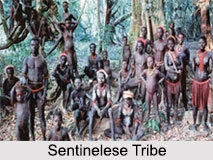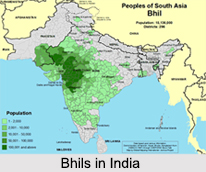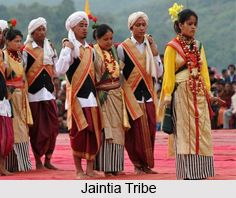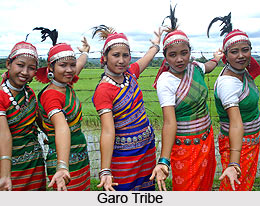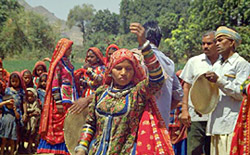Bandai puja, constituting a significant part of the cultural life of the Kharia Tribes, is celebrated with great enthusiasm and gusto. The spirit of Goria Darha is believed to protect their cattle and possess great power that wards off all evils. Thus, the spirit requires to be appeased as its displeasure might cause epidemics. Thus, every family who domesticate cattle, perform this puja for the betterment of cattle. The Kharia generally performs two Bandai Puja; one for buffaloes and the other for cows and bullocks.
Propitiation ceremony of spirit for the buffaloes is performed on the first moon day of the Hindi month, Kartik while the propitiation ritual for the cows and bullocks are performed on the full moon day of Kartik. The buffalo worship and cow worship are known as Bhains chuman and Gai chuman respectively. The rituals and process of performance of the ceremony vary accordingly.
Bhains Chuman
On the first moon day of the Hindi month of Kartika, the male and female heads of the family observe fast. Early in the morning the male head proceeds towards the jungle jungle or to the grazing field with his cattle. During the evening hours the buffaloes are brought back for bathing while the female head prepares for worship. In the shed, she plasters a particular place with cow dung and places Gulaichi flower and arwa rice in a winnowing fan as well as three wicks over three Shakhua leaves. The lighted wicks are installed at the entrance door of the store house, in the cattle shed and at the place of pooja. Upon the arrival of the cattle raw milk mixed with water is poured at the feet of the buffaloes and then washed. The milk may also be sprinkled over the feet of the cattle. Thereafter, five heaps of arwa rice are placed over the cleansed spot and five chickens are fed on these rice heaps, one after the other. These chickens are then touched over different parts of the body of the buffalo and finally hit at the head of the buffalo with a strong blow, killing it.
Immediately after this event, oil is smeared over the horns of the buffalo. The sacrificial fowl is cooked and consumed by the male members of the particular clan. Intake of the food is combined with drinking of Golang i.e. rice bear. A sacred thread made up of grass is also used during this ceremony. As per the historical records of the Kharia, the tribal group used the sacred thread long before the Brahmins and with time stopped using it. The usage of the sacred thread in this ceremony serves as a reminder of this custom. The wicks are allowed to burn far the whole night while drinking, singing and merry making continues. The meat of the consecrated fowls and rice-beer are drunk by family members except the girls.
The following day Pakhowa is celebrated when boiled urid (Phascolus Roxburghii) and boiled rice are consumed by the male head in an open place. The buffaloes are also served food in the outskirt of the village.
Gai-Bail Chuman
Gai and Bail Chuman is also celebrated by the Kharias in the same manner as Bhains Chuman except the in the same manner except the fact that while the Bhains Chuman is celebrated at night, Gai Bail Chuman is performed during day time. Prior to the sacrifice of fowls, the head of the family offers worship to God facing the east side. During the prayer the Supreme Being is eulogized and the tales of migrations of the ancestors of the Kharia are narrated. Pakhowa is also performed.

















